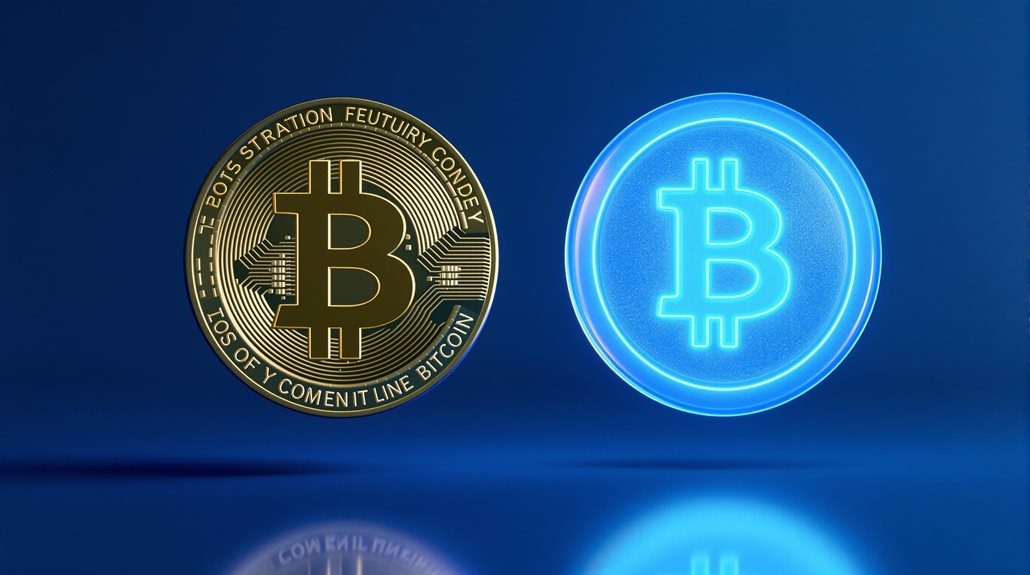Coins and tokens serve different purposes in cryptocurrency. Coins, like Bitcoin and Ethereum, have their own blockchain networks and primarily function as digital money. Tokens, however, are built on existing blockchains and can represent various assets or rights, such as voting power in decentralized applications. While coins need independent networks with miners or validators, tokens use smart contracts on established platforms. Understanding these distinctions helps navigate the complex world of digital assets.
Quick Overview
- Coins have their own blockchain (like Bitcoin), while tokens are built on existing blockchains (like ERC-20 tokens on Ethereum).
- Coins primarily function as digital currency, whereas tokens can represent various assets, rights, or utilities within specific platforms.
- Creating a coin requires developing an entire blockchain network, but tokens can be easily created using smart contracts.
- Coins generally offer more stability and liquidity for trading, while tokens often serve specific purposes within decentralized applications.
- Transaction fees on any blockchain are paid in its native coin, not tokens, making coins essential for network operations.

Newcomers to cryptocurrency often struggle to understand the difference between coins and tokens. While they’re both digital assets, they serve different purposes and work in distinct ways. The main difference is that coins have their own blockchain, while tokens are built on top of existing blockchain platforms.
Coins function primarily as digital money and include well-known cryptocurrencies like Bitcoin, Ethereum, and Litecoin. They’re created through mining or minting processes and operate on their own independent networks. These networks need miners or validators to verify transactions and maintain the blockchain’s security. A key distinction is that coins are native to their blockchain. Coins are typically decentralized, meaning no single entity controls them, and they’re commonly used for buying, selling, and storing value. Coins have proven to be more stable for trading compared to most tokens in the cryptocurrency market.
Tokens, on the other hand, don’t have their own blockchain. Instead, they’re created using smart contracts on established platforms like Ethereum. Popular tokens include USDT, LINK, and UNI. The ERC20 standard ensures all tokens on Ethereum follow the same rules and can interact seamlessly with each other. Creating tokens is relatively simple compared to developing a new coin, which explains why there are so many tokens in the crypto market. Tokens can represent various things, from digital assets to voting rights in decentralized organizations.
The technical differences between coins and tokens are significant. Coins require their own network of miners or validators and unique blockchain architecture. Tokens follow specific standards, like ERC-20 on the Ethereum network, and rely on their host blockchain’s consensus mechanism to function. When people use a blockchain network, they pay transaction fees (gas fees) in that network’s native coin, not in tokens.
As of 2023, there are more than 20,000 different cryptocurrencies in existence. Coins generally have larger market capitalizations and are more liquid, meaning they’re easier to buy and sell. Tokens are more numerous because they’re easier to create, but they’re often designed for specific applications or purposes within decentralized apps (dApps).
The distinction between coins and tokens isn’t just technical – it affects how they’re used in the real world. While coins primarily serve as digital currency, tokens can represent anything from ownership rights in a project to access to specific services. Some tokens are centralized, meaning a single organization controls them, while others operate in a decentralized manner like most coins.
Understanding these differences helps people navigate the cryptocurrency ecosystem more effectively.
Frequently Asked Questions
How Do I Safely Store My Cryptocurrency Coins and Tokens?
Cryptocurrency can be stored in two main ways.
Hardware wallets are physical devices that keep crypto offline and are considered the most secure option.
Software wallets are digital apps that store crypto on phones or computers, making them convenient for regular use.
Many people use both types – hardware wallets for long-term storage and software wallets for everyday transactions.
Each method has different security features and backup systems.
Can Tokens Be Converted Directly Into Traditional Fiat Currency?
Direct token-to-fiat conversion isn’t typically possible. Most tokens need to be converted to major cryptocurrencies first, like Bitcoin or Ethereum.
It’s usually a multi-step process: tokens are swapped for cryptocurrency, then the crypto is sold for traditional money.
While some platforms are starting to offer direct token-to-fiat services, they’re not common. The whole process can involve multiple fees and usually takes several days to complete.
Which Exchanges Allow Trading Both Coins and Tokens?
Most major exchanges support trading both coins and tokens. Centralized exchanges like Binance, Coinbase, Kraken, KuCoin, and Gemini offer trading for both.
Decentralized exchanges (DEXs) like Uniswap and PancakeSwap primarily focus on token trading but also support some coins.
Hybrid exchanges like Nash and Qurrex handle both types too. Each platform has its own list of supported cryptocurrencies, and they regularly update which ones they allow for trading.
Are Lost Coins and Tokens Recoverable Through Blockchain Technology?
Lost crypto assets have different recovery chances.
Native blockchain coins, like Bitcoin, are usually harder to recover – especially if stored on damaged hardware or if private keys are lost.
Tokens, built on existing blockchains, might be easier to recover through smart contracts or platform-specific features.
While some recovery services exist, success isn’t guaranteed.
It’s estimated that millions of Bitcoin are permanently lost, worth billions of dollars.
Do Cryptocurrency Coins and Tokens Have Expiration Dates?
Most cryptocurrency coins and tokens don’t have expiration dates. They’ll exist as long as their blockchain networks keep running.
However, some tokens might have built-in vesting periods or lock-up times that control when they can be used.
While the coins themselves don’t expire, cryptocurrency derivatives like futures and options do have specific expiration dates.
It’s worth noting that coins can become obsolete if their networks lose support or stop being used.





